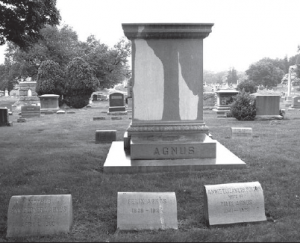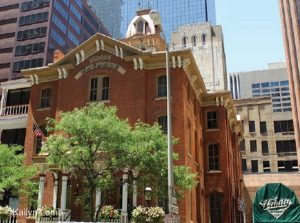One of the monuments at Druid Ridge Cemetery at which people have reported experiencing various paranormal phenomena—including sensing a spiritual presence, seeing apparitions, and capturing mists and orbs in photographs—is the Marburg family mausoleum, in front of which is a bronze figure of Icarus.
 The base of this statue is fitted with a plaque dedicating it to Theodore Marburg Jr., which mentions his service with the British Royal Flying Corps during World War I and includes some rather strange verbiage about the need for an American presence in Europe. It also indicates that Theodore was born in 1893 and died in 1922, begging the question of how he might have died not during the war but a mere four years after it ended.
The base of this statue is fitted with a plaque dedicating it to Theodore Marburg Jr., which mentions his service with the British Royal Flying Corps during World War I and includes some rather strange verbiage about the need for an American presence in Europe. It also indicates that Theodore was born in 1893 and died in 1922, begging the question of how he might have died not during the war but a mere four years after it ended.
Investigation after our return from the site revealed the strange, convoluted, almost gothic history of the Marburg family in general and the macabre events surrounding the death of Theodore in particular. A brief review of Theodore’s life during and after the war would certainly suggest he was an almost classically tormented soul, and it was not hard to believe he might haunt the final resting place of his remains.
When the Great War began, Theodore was a student at Oxford, in England, and in the furor to stop the German advance across Europe he joined the British Royal Flying Corps—despite the fact that Americans were prohibited from serving in foreign military organizations and that his father was a career diplomat and a friend of former President William Howard Taft.
In 1916, Theodore’s plane crashed while flying a frontline mission and, as a result of the injuries he sustained, he had to have his left leg amputated. During his convalescence, he met and married a Belgian baroness who was a divorcee and the mother of a 3-year-old girl. The baroness also had a background that was, suffice it to say, a bit questionable.
Not much about the couple’s life together is known, but two years later, when Theodore became a partner in a cattle ranch in New Mexico, the baroness refused to go with him. In an exception to the norms of the era, he claimed abandonment and they were divorced shortly thereafter.
In early January 1922, Theodore was married again, this time to a woman 10 years his junior. She was not with him at his ranch when he put an automatic pistol to his head seven weeks later and shot himself. It took him a week to die, during which the doctors had to remove his eyes. His wife arrived from Baltimore after he had expired.
There is a lot that is not known about the mounting tragedies that afflicted Theodore in life, but it is not too hard to imagine that his tormented spirit might still linger on our own sphere after his earthly troubles were brought to an end. But, as it turns out, a number of the other Marburgs have weird stories, as well, and it is easy to conceive of any number of them lingering on as ghosts. These include Theodore Marburg Sr., a man who cultivated a reputation as a peacemaker but urged the United States to enter World War I, and his sister, an increasingly desperate spinster who at one point unsuccessfully offered a European tour guide $200,000 to marry her (he declined, opting for her niece instead). Any of them—maybe all of them—might be among the spirits that continue to linger among the sepulchers and monuments of Druid Ridge Cemetery.
For more haunted tales, check out Ghosthunting Maryland by Michael J. Varhola.
